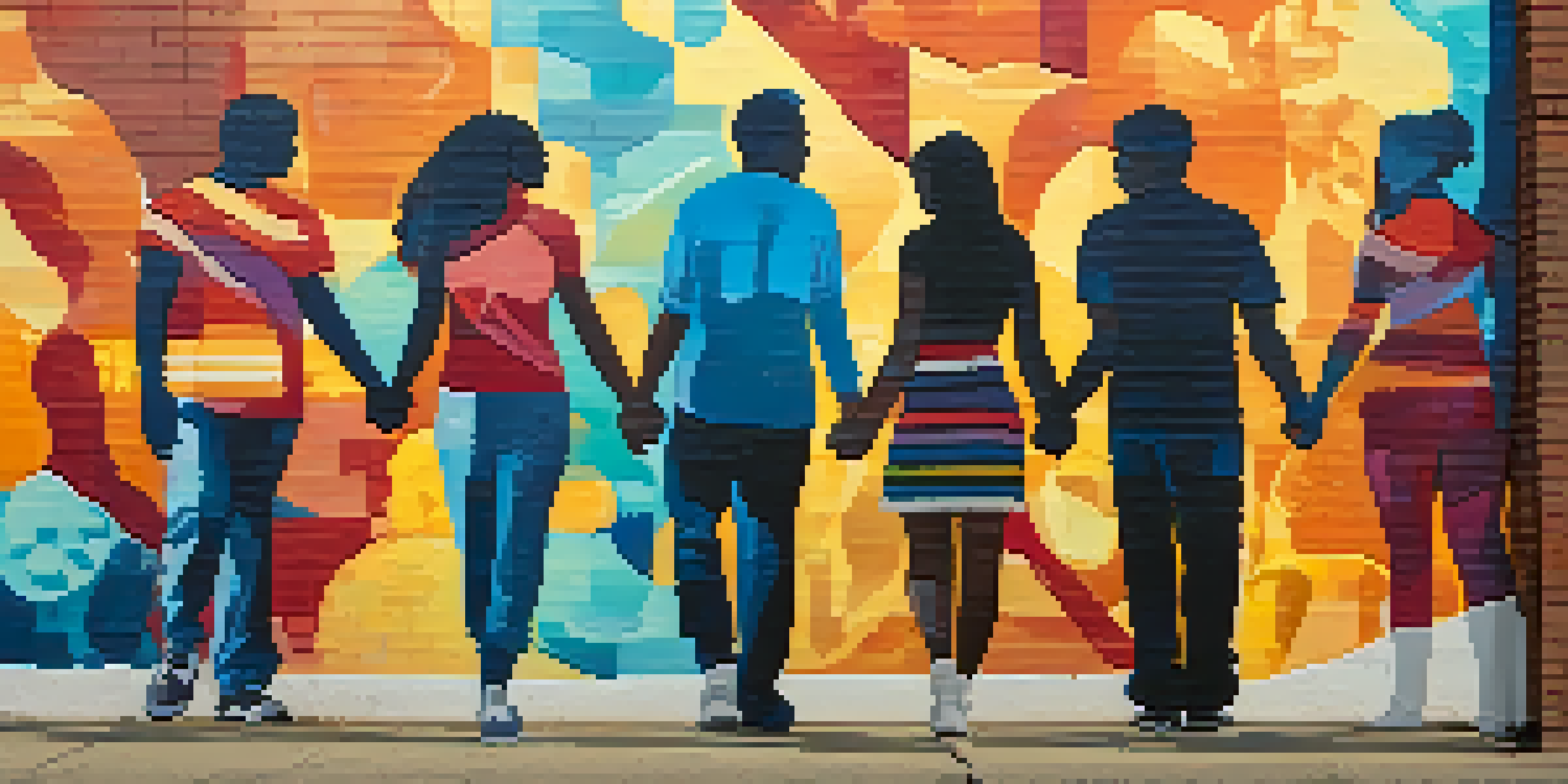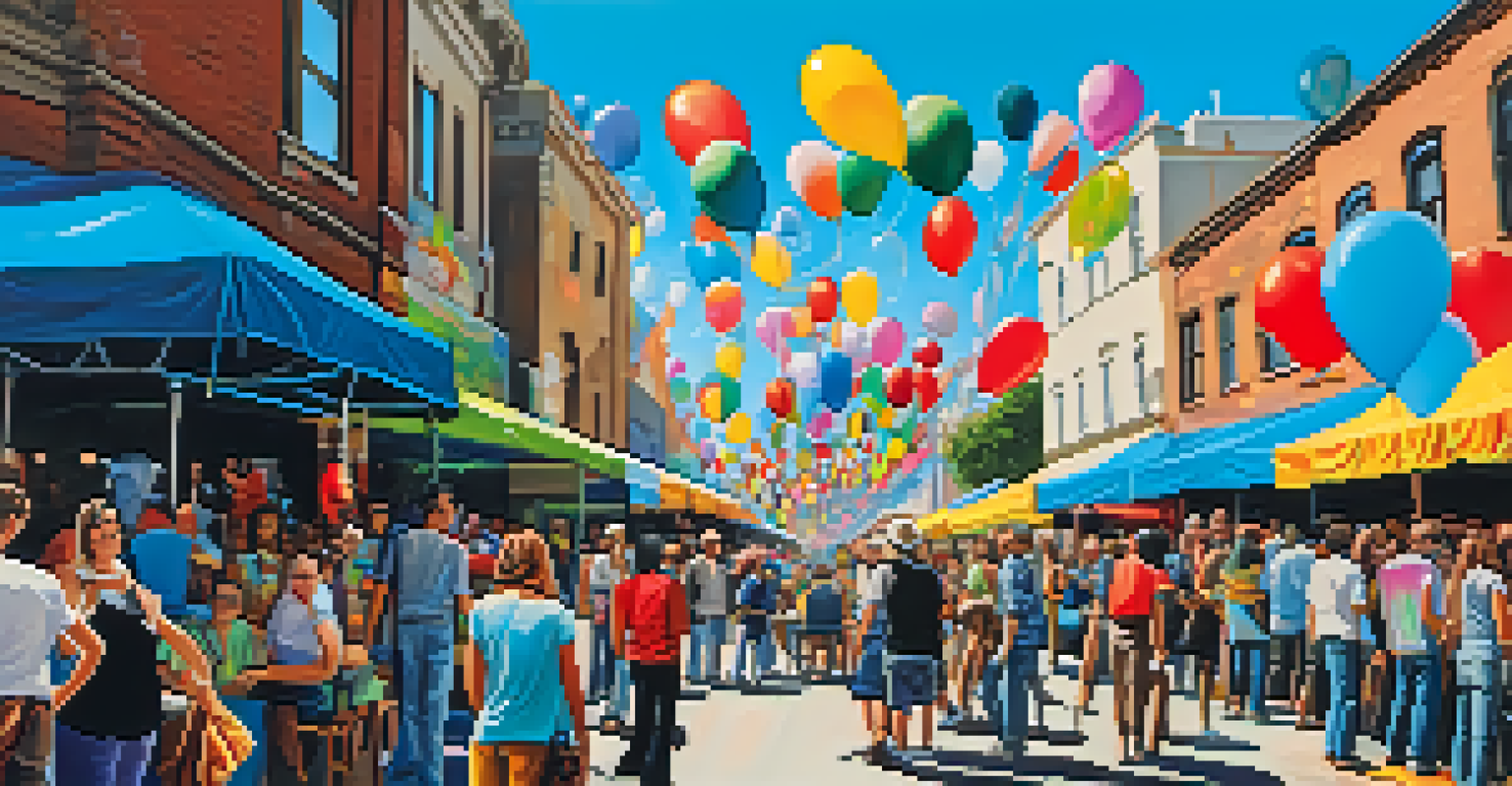Street Art as a Catalyst for Community Empowerment and Change

Understanding Street Art and Its Cultural Significance
Street art is more than just vibrant murals and graffiti; it's a powerful form of expression that reflects the culture and history of a community. Often created in public spaces, it serves as a visual commentary on social issues, making art accessible to everyone, regardless of their background. This artistic medium has roots in various movements, from political protests to cultural celebrations, illustrating its ability to resonate with diverse audiences.
Street art is a way of expressing the human condition, a way to communicate and connect with others.
Beyond aesthetics, street art fosters a sense of belonging. When locals see their stories, struggles, and triumphs depicted on walls, it creates a shared identity and pride that can uplift the community. Think of it as a visual conversation that speaks volumes about the realities and aspirations of the people living there.
Moreover, street art can challenge societal norms and provoke thought. By addressing issues like inequality, racism, and environmental concerns, artists encourage dialogue and inspire action. In this way, street art becomes a reflective mirror, showing not just the beauty but also the challenges that a community faces.
Street Art as a Voice for Marginalized Communities
For many marginalized groups, street art is a vital outlet for self-expression and advocacy. It offers a platform where voices that are often overlooked or silenced can resonate loudly. Artists from these communities use their craft to highlight their experiences and call attention to injustices they face, creating awareness and empathy among broader audiences.

Consider the murals that depict stories of struggle and resilience among immigrant communities. These works not only memorialize personal experiences but also foster solidarity among members of the community, igniting a sense of unity and purpose. When people see their narratives portrayed through street art, it validates their experiences and empowers them to engage with their surroundings more actively.
Street Art as Community Expression
Street art serves as a powerful medium for communities to express their identity, culture, and social issues, fostering belonging and pride.
Additionally, this form of art can serve as a rallying point for social movements. By transforming public spaces into canvases for change, artists can inspire collective action. Street art not only tells stories but also mobilizes communities to stand together and advocate for their rights.
How Street Art Enhances Community Identity and Pride
Street art contributes significantly to a neighborhood's identity, turning ordinary spaces into extraordinary places. When murals adorn the walls of a community, they become landmarks that people are proud to share. This transformation often attracts visitors, fostering economic growth and encouraging local businesses to thrive.
Art is the most beautiful of all lies; it is the truth that we can all understand.
Moreover, these artistic expressions can create a sense of ownership among residents. When community members participate in creating or maintaining street art, it fosters a connection to their environment. This involvement not only beautifies the area but also instills a sense of responsibility and pride in maintaining the space.
For instance, a once-neglected alley can become a vibrant gallery, showcasing local talent and history. This shift not only transforms the physical landscape but also nurtures an emotional bond with the community, enhancing social cohesion and making people feel more connected to where they live.
Street Art: A Tool for Social Commentary and Change
Street artists often use their work to comment on pressing social issues, making them powerful catalysts for change. Through thought-provoking imagery and bold statements, they can highlight topics like climate change, inequality, and systemic injustice. This ability to communicate complex issues visually makes street art a compelling medium for sparking conversations.
For example, a mural depicting the impacts of pollution can raise awareness about environmental issues in a way that statistics and reports may not. By invoking emotions and prompting discussions, street art encourages individuals to reflect on their role in societal challenges and inspires them to take action.
Empowerment Through Collaboration
Collaborative street art projects unite artists and residents, creating a sense of ownership and strengthening community bonds.
Furthermore, the transient nature of street art—often temporary and evolving—mirrors the dynamic conversations surrounding these issues. As new artworks replace old ones, they symbolize ongoing struggles and victories within the community, keeping the dialogue fresh and relevant.
Collaborative Projects: Uniting Artists and Communities
Collaborative street art projects are a fantastic way to bring artists and community members together, fostering teamwork and shared visions. These initiatives often involve workshops, where residents can contribute ideas and designs, ensuring that the resulting artwork reflects the community's values and aspirations. This participatory approach not only empowers individuals but also strengthens community bonds.
Such collaborations can lead to powerful murals that encapsulate the collective identity of the neighborhood. When everyone has a hand in the creation process, it cultivates a sense of pride and ownership over the finished product. Each brushstroke becomes a testament to the community's story, told through the diverse perspectives of its members.
Moreover, these projects can bridge generational gaps, allowing older and younger community members to connect through art. By sharing skills and experiences, participants can foster understanding and respect, creating a more inclusive environment where everyone feels valued.
Street Art Festivals: Celebrating Creativity and Community
Street art festivals have become vibrant celebrations of creativity, drawing artists and spectators from all walks of life. These events not only elevate the profile of street art but also encourage community engagement, turning neighborhoods into dynamic hubs of artistic expression. By showcasing local talent alongside international artists, festivals highlight the rich tapestry of cultural influences present in the community.
During these festivals, residents often come together to enjoy live music, food, and art-making activities, creating a festive atmosphere that strengthens community ties. These shared experiences foster camaraderie and pride, reminding everyone of the importance of creativity in bringing people together.
Catalyst for Social Change
Street art highlights pressing social issues, encouraging dialogue and inspiring action within communities.
Additionally, street art festivals can have lasting impacts on communities, as the artworks created during these events often become permanent fixtures. This legacy of creativity not only beautifies the neighborhood but also serves as a reminder of the collaborative spirit that brought the artwork to life.
The Future of Street Art in Community Development
As cities evolve, the role of street art in community development is becoming increasingly recognized. Urban planners and local governments are starting to see the value of integrating street art into revitalization efforts, understanding its potential to enhance public spaces and engage residents. This shift heralds a new era where art becomes a key element in urban design and community planning.
In the future, we can expect to see more initiatives aimed at supporting street artists and encouraging community involvement in art projects. With funding and resources directed toward these endeavors, communities will have the opportunity to harness the power of art to address their unique challenges and aspirations.

Ultimately, street art has the potential to shape not only the aesthetic landscape but also the social fabric of communities. By nurturing creativity and fostering dialogue, it can serve as a foundation for ongoing empowerment and change, making neighborhoods more vibrant, inclusive, and resilient.